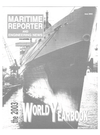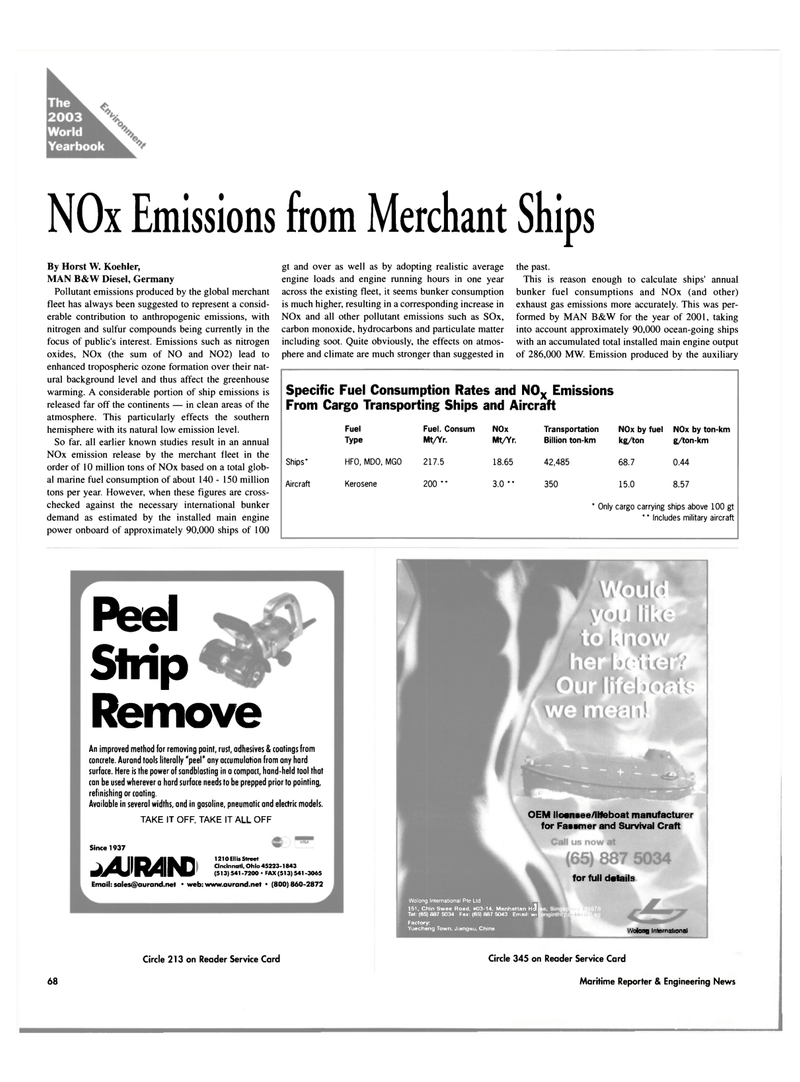
Page 68: of Maritime Reporter Magazine (June 2003)
Read this page in Pdf, Flash or Html5 edition of June 2003 Maritime Reporter Magazine
NOx Emissions from Merchant Ships
By Horst W. Koehler,
MAN B&W Diesel, Germany
Pollutant emissions produced by the global merchant fleet has always been suggested to represent a consid- erable contribution to anthropogenic emissions, with nitrogen and sulfur compounds being currently in the focus of public's interest. Emissions such as nitrogen oxides, NOx (the sum of NO and N02) lead to enhanced tropospheric ozone formation over their nat- ural background level and thus affect the greenhouse warming. A considerable portion of ship emissions is released far off the continents — in clean areas of the atmosphere. This particularly effects the southern hemisphere with its natural low emission level.
So far. all earlier known studies result in an annual
NOx emission release by the merchant fleet in the order of 10 million tons of NOx based on a total glob- al marine fuel consumption of about 140 - 150 million tons per year. However, when these figures are cross- checked against the necessary international bunker demand as estimated by the installed main engine power onboard of approximately 90,000 ships of 100 gt and over as well as by adopting realistic average engine loads and engine running hours in one year across the existing fleet, it seems bunker consumption is much higher, resulting in a corresponding increase in
NOx and all other pollutant emissions such as SOx, carbon monoxide, hydrocarbons and particulate matter including soot. Quite obviously, the effects on atmos- phere and climate are much stronger than suggested in the past.
This is reason enough to calculate ships' annual bunker fuel consumptions and NOx (and other) exhaust gas emissions more accurately. This was per- formed by MAN B&W for the year of 2001, taking into account approximately 90,000 ocean-going ships with an accumulated total installed main engine output of 286,000 MW. Emission produced by the auxiliary
Specific Fuel Consumption Rates and NOx Emissions
From Cargo Transporting Ships and Aircraft
Fuel Fuel. Consum NOx Transportation NOx by fuel NOx by ton-km
Type Mt/Yr. Mt/Yr. Billion ton-km kg/ton g/ton-km
Ships* HF0, MD0, MGO 217.5 18.65 42,485 68.7 0.44
Aircraft Kerosene 200 ** 3.0 ** 350 15.0 8.57 * Only cargo carrying ships above 100 gt * * Includes military aircraft
Peel
Strip
Remove
An improved method for removing paint, rust, adhesives & coatings from concrete. Aurand tools literally "peel" any accumulation from any hard surface. Here is the power of sandblasting in a compact, hand-held tool that can be used wherever a hard surface needs to be prepped prior to pointing, refinishing or coating.
Available in several widths, and in gasoline, pneumatic and electric models.
TAKE IT OFF, TAKE IT ALL OFF
Since 1937
JAJRAID 1210 EIILs Street Cincinnati, Ohio 45223-1843 (513)541-7200 • FAX (513) 541-3065
Email: [email protected] • web: www.aurand.net • (800)860-2872
Wolong International Pte Ltd 151, Chin Swee Road, #03-14, Manhattan H<3
Tel: (65) 007 5034 Fax: (65) 887 5043 Email: w«
Factory:
Yuecheng Town, Jiangau, China
OEM licensee/lifeboat manufacturer for Fassmer and Survival Craft for full details
Wolong International 68
Circle 213 on Reader Service Card Circle 345 on Reader Service Card
Maritime Reporter & Engineering News

 67
67

 69
69
